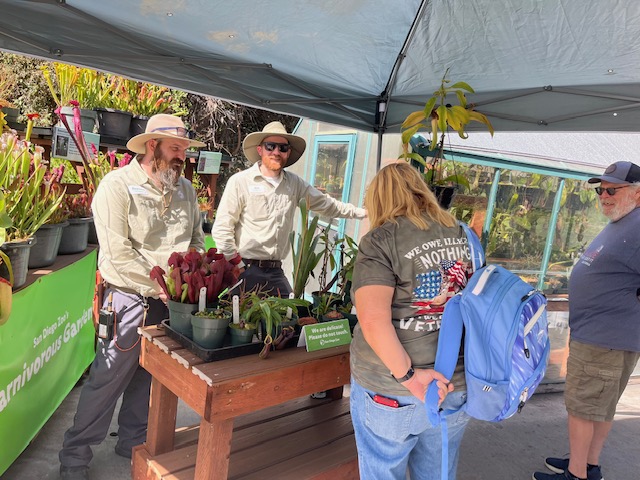Carnivorous Plants at the San Diego Zoo Wildlife Alliance
Carnivorous plants are one of the marvels of the plant world. Carnivory has developed independently in 15 plant families (3 monocot and 12 dicot) with over 580 species described and new species being discovered each year. These unusual plants can be found on all continents except Antarctica growing in nutrient poor soils, requiring these plants to develop alternative means for acquiring nitrogen and phosphorous needed for metabolic processes. Modified leaves primarily trap insects, or in the case of aquatic plants, protozoans.
Carnivorous plants have devised several types of traps to capture prey: pitfall, snap traps, fly paper, lobster pots and bladder (vacuum). Passive traps rely on sticky or slippery surfaces to cause prey to stick or slide into the digestive fluid. Pitfalls, such as those found in Nepenthes, Heliamphora, and Brocchinia rely on slippery surfaces; while Drosera, Pinguicula, and Drosophyllum are examples of genera that depend on flytraps – sticky glandular hairs that coat prey with mucilage. Lobster traps are leaves that use hairs to prevent prey from exiting once they are lured into the trap. This type of trap is found in Genlisea. Bladder traps are only found in Utricularia, an aquatic genus of carnivorous plants, where a bladder uses a vacuum to suck protozoans into the trap. Active or “snap” traps are found in Dionaea and Aldrovanda. Trigger hairs signal when it’s time to snap shut on unwary prey. In each case, specialized cells in the leaf excrete digestive fluids that break down the prey and are then reabsorbed into the leaf.

Despite the occurrence of carnivorous plants in many areas of the world, many are under threat due to habitat loss, climate change and illegal collection from the wild. At the San Diego Zoo Wildlife Alliance (SDZWA), the horticulture department has developed a robust collection of carnivorous plants, with over 90 species from several families, and new additions being acquired annually.
The majority of our collection is comprised of Nepenthes species, with many of them ranked from vulnerable to critically endangered. Twelve of the Nepenthes species under our care are listed as critically endangered by IUCN. Three of the most endangered Nepenthes in our collection are:
- N. khasiana is the only species native to India where it occurs in isolated populations. An endangered species, Nepenthes khasiana produces a sweet nectar that also contains a disorienting neurotoxin that increases the likelihood of prey falling into the trap. This species also fluoresces on its peristome and underside of the lid as a method of attracting prey.
- N. aristolochioides is a species endemic to the highlands of Sumatra and is critically endangered due to overcollection. The mouth of the pitcher is held at an almost vertical angle, and the digestive fluid inside is thick and syrupy.
- N. clipeata: an extremely rare species found only on Mt. Kelam, Borneo. Populations of this beautiful species have been drastically reduced by fires and overcollection. With few mature specimens left in the wild, it is feared this species is functionally extinct in its native habitat.
Our efforts in the SDZWA horticulture department are aimed at cultivating a diverse and healthy ex situ population of these rare species against the threat of extinction. As our specimens mature, we hope to participate in breeding programs with partner institutions to ensure the genetic diversity of each species is preserved.
As part of our public outreach, we have collection specialists set up displays and discuss our work at monthly Plant Days and Wild Weekends, as well as give presentations in our summer camp program and to other groups. Our collection has been featured on TV and podcasts. Those in San Diego wishing to learn more about these unique plants can visit the Zoo on the third Friday of every month to see them up close and ask the horticulture team any questions about all things botanical.
-

Drosera in the San Diego Zoo Wildlife Alliance's collection. Photo credit: Adam Painter. -

SDZWA horticulture team members talking with guests about their carnivorous plant collection at a Plant Day event, which typically engage 600-700+ guests during these monthly events. Photo courtesy of the San Diego Zoo Wildlife Alliance. -

Nepenthes in the San Diego Zoo Wildlife Alliance's collection. Photo credit: Adam Painter.